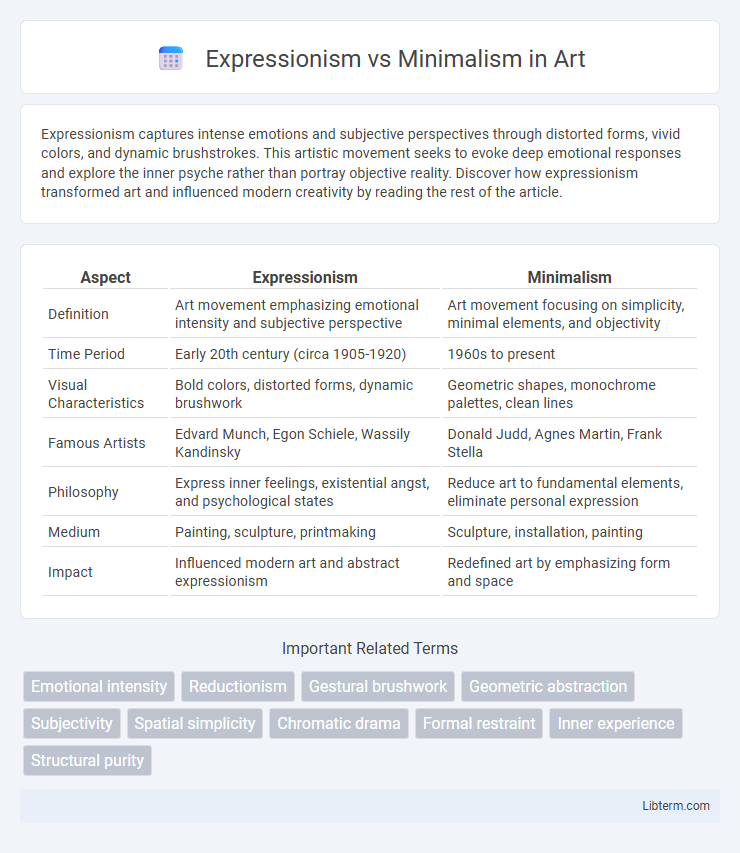Expressionism captures intense emotions and subjective perspectives through distorted forms, vivid colors, and dynamic brushstrokes. This artistic movement seeks to evoke deep emotional responses and explore the inner psyche rather than portray objective reality. Discover how expressionism transformed art and influenced modern creativity by reading the rest of the article.
Table of Comparison
| Aspect | Expressionism | Minimalism |
|---|---|---|
| Definition | Art movement emphasizing emotional intensity and subjective perspective | Art movement focusing on simplicity, minimal elements, and objectivity |
| Time Period | Early 20th century (circa 1905-1920) | 1960s to present |
| Visual Characteristics | Bold colors, distorted forms, dynamic brushwork | Geometric shapes, monochrome palettes, clean lines |
| Famous Artists | Edvard Munch, Egon Schiele, Wassily Kandinsky | Donald Judd, Agnes Martin, Frank Stella |
| Philosophy | Express inner feelings, existential angst, and psychological states | Reduce art to fundamental elements, eliminate personal expression |
| Medium | Painting, sculpture, printmaking | Sculpture, installation, painting |
| Impact | Influenced modern art and abstract expressionism | Redefined art by emphasizing form and space |
Introduction to Expressionism and Minimalism
Expressionism emphasizes intense emotional experience through vivid colors, distorted forms, and dynamic brushstrokes, aiming to evoke subjective feelings rather than realistic representation. Minimalism contrasts this by stripping art down to its essential elements, using simple geometric shapes, monochromatic palettes, and clean lines to highlight purity and objectivity. Both movements challenge traditional aesthetics but express fundamentally different artistic philosophies and visual languages.
Historical Origins and Evolution
Expressionism originated in the early 20th century, primarily in Germany, as a reaction against realism and industrialization, emphasizing emotional experience through distortion and vivid color. Minimalism emerged in the 1960s in the United States as a counter-movement to Abstract Expressionism, focusing on simplicity, geometric forms, and the use of industrial materials to remove personal expression. The evolution of Expressionism influenced various art forms, including painting and cinema, while Minimalism redefined sculpture and design by promoting clarity and objectivity.
Key Philosophies and Principles
Expressionism emphasizes emotional intensity, individual perspective, and the exploration of subjective experience through bold colors, dynamic forms, and dramatic compositions. Minimalism focuses on simplicity, objectivity, and the use of basic geometric shapes, often employing monochromatic palettes and repetitive patterns to eliminate personal expression and highlight pure form. Both movements challenge traditional aesthetics but diverge in their approach: Expressionism seeks to evoke inner feelings, whereas Minimalism aims to present art as an autonomous, impersonal object.
Visual Characteristics of Expressionism
Expressionism is characterized by intense, vivid colors, distorted forms, and energetic brushstrokes that convey emotional intensity and subjective experience. The visual style often features exaggerated shapes and dynamic compositions, emphasizing inner feelings over realistic representation. This contrasts sharply with Minimalism's focus on simplicity, clean lines, and neutral color palettes that eliminate personal expression in favor of objective clarity.
Defining Traits of Minimalism
Minimalism emphasizes simplicity, using clean lines, monochromatic palettes, and geometric forms to create a sense of order and clarity. It strips away excess detail to focus on essential shapes and materials, often incorporating repetition and industrial elements. The movement values space and light, encouraging viewers to engage with the work's form and environment rather than emotional content.
Influential Artists and Works
Expressionism, characterized by emotional intensity and bold brushstrokes, was shaped by artists like Edvard Munch with his iconic work "The Scream" and Egon Schiele's raw, distorted figures. Minimalism, emphasizing simplicity and geometric forms, was advanced by artists such as Donald Judd, known for his precise metal sculptures, and Agnes Martin, whose subtle grid paintings highlight minimalistic aesthetics. These influential artists defined their movements through contrasting approaches to color, form, and emotional expression.
Emotional Impact and Audience Engagement
Expressionism evokes intense emotional impact through bold colors, dynamic brushstrokes, and distorted forms, engaging audiences by conveying raw, subjective experiences. Minimalism relies on simplicity, geometric forms, and repetition to create a contemplative atmosphere, encouraging viewers to engage by finding meaning in subtle details and spatial relationships. The contrast between Expressionism's emotional intensity and Minimalism's restrained serenity shapes distinct modes of audience interaction and psychological response.
Techniques and Materials Used
Expressionism employs bold brushstrokes, vivid colors, and textured surfaces to evoke intense emotional responses, often using oil paints, impasto, and mixed media on canvas. Minimalism relies on geometric shapes, clean lines, and monochromatic palettes, utilizing industrial materials such as steel, glass, and concrete to emphasize simplicity and spatial harmony. The contrast between raw, gestural techniques in Expressionism and the precise, reductive methods in Minimalism highlights their differing artistic philosophies.
Influence on Contemporary Art
Expressionism's emphasis on emotional intensity and bold colors profoundly influenced contemporary art by encouraging artists to explore personal narratives and abstract forms. Minimalism's focus on simplicity, geometric shapes, and the use of negative space reshaped concepts of form and viewer interaction, promoting a meditative and conceptual approach. Together, these movements expanded the artistic vocabulary, inspiring diverse practices in painting, sculpture, and installation art.
Expressionism vs Minimalism: Which Resonates Today?
Expressionism, characterized by bold colors and emotional intensity, contrasts sharply with Minimalism's focus on simplicity and form. Contemporary audiences resonate with Expressionism's raw emotional power in an era seeking personal and social reflection, while Minimalism appeals through its clarity and reductionism amid digital noise. The ongoing dialogue between these movements highlights a cultural balance between expressive freedom and disciplined restraint.
Expressionism Infographic

 libterm.com
libterm.com